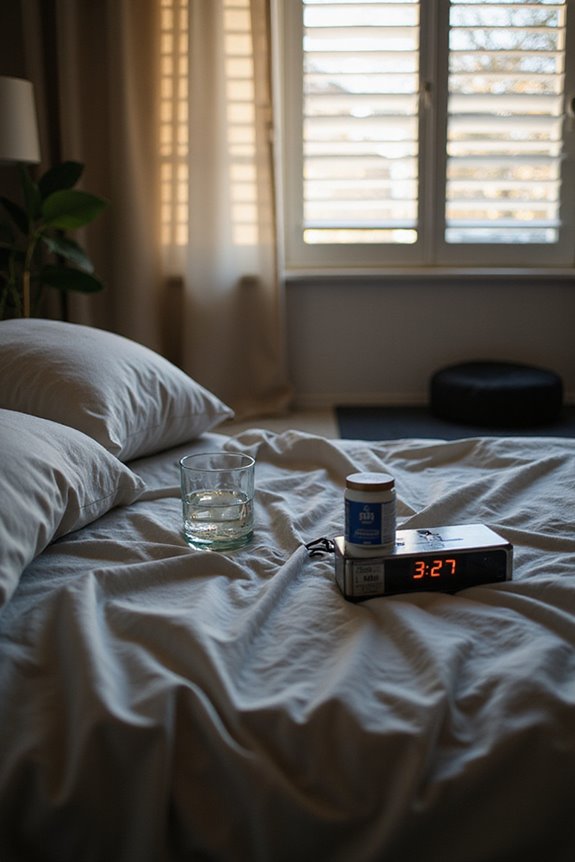Chronic pain has a profound impact on overall quality of life. Key effects include:
- Physical Functioning: 8.7% of patients show significant improvement in physical function.
- Employment: 24.3% of U.S. adults report chronic pain; 19% lose jobs.
- Social Life: Individuals experience emotional isolation and social withdrawal.
- Mental Health: 20% to 45% exhibit depression or anxiety.
These factors combine to undermine daily living and overall well-being. Further insights into these dynamics are available.
Key Takeaways
- Chronic pain affects physical functioning, leading to decreased muscle strength and limited mobility, which impacts daily activities and overall quality of life.
- It significantly influences professional life, resulting in reduced work productivity and increased unemployment rates due to severe pain symptoms.
- Socially, individuals with chronic pain often experience isolation, fewer friendships, and challenges in communication, which negatively impacts emotional well-being.
- Mood disturbances, including anxiety and depression, are common, creating a negative feedback loop that exacerbates pain perception and emotional distress.
- Chronic pain leads to unmet mental health needs, highlighting the importance of integrated care for improving overall quality of life.
Prevalence and Demographics of Chronic Pain
Chronic pain is a significant global health issue, affecting approximately 20% of adults, which translates to over 1.5 billion individuals worldwide.
- Global Distribution: The prevalence of chronic pain varies, ranging from 13% to 51% in developing countries across Latin America, Asia, and Africa.
- Age Trends: The risk increases with age, particularly affecting older adults who are more susceptible to musculoskeletal and neuropathic pain.
- Regional Insights: High prevalence rates are noted in Tunisia (79.6%), the Dominican Republic (64%), and Moldova (61%).
- Developed Regions: In the European Union, around 100 million individuals live with chronic pain, while the U.S. reports approximately 30.7%.
These statistics highlight the complex landscape of chronic pain across different populations and regions.
Impact on Physical Functioning

The impact of chronic pain on physical functioning is profound, with significant implications for individuals’ daily lives.
- Lower pain interference is strongly correlated with higher physical function (r = −0.65 after 90 days).
- Only 8.7% of patients show significant improvement in both pain interference and physical function after 90 days.
- Kinesiophobia, or fear of movement, leads to increased sedentary behavior, affecting overall physical activity levels.
- Elevated pain and depression levels impair physical performance, particularly in elderly populations.
- Chronic pain results in decreased muscle strength, flexibility, and aerobic capacity.
Effective pain management and targeted functional rehabilitation are essential to mitigate these effects, promoting improved physical capabilities and overall quality of life. Using heating pads for pain relief can be an effective method to alleviate discomfort and enhance physical function.
Effects on Professional Life and Employment

Employment opportunities and work participation are considerably affected by pain conditions, as individuals facing chronic pain often encounter barriers that hinder their professional lives.
- In 2023, 24.3% of U.S. adults reported chronic pain, with 8.5% experiencing frequent limitations in life or work activities.
- Workers with severe pain symptoms are twice as likely to be unemployed after 18 months (33% vs. 16%).
- A European survey indicated that 19% lost their jobs due to pain, while 16% altered job responsibilities.
- Chronic pain reduces work productivity by an average of 2.4 to 9.8 hours weekly, impairing job performance.
- Many individuals require workplace accommodations or shift to less physically demanding roles, impacting overall workforce participation.
Influence on Relationships and Social Life

Influencing relationships and social life, chronic pain often leads to significant changes in social dynamics.
- Individuals with chronic pain experience social withdrawal, reporting fewer friendships and heightened feelings of emotional isolation.
- Communication barriers arise as friends and family may struggle to understand pain experiences, which can strain relationship dynamics.
- Limited social engagement is common, often due to physical limitations that hinder participation in gatherings or daily activities.
- Stigma awareness is critical, as the invisibility of chronic pain symptoms can exacerbate misunderstandings and emotional distress.
- Strong support networks are essential, as they can mitigate the impact of emotional distress, helping individuals develop effective coping strategies.
- Ultimately, these factors contribute to a cyclical relationship between chronic pain and social connectivity.
Disruption of Sleep Patterns

Chronic pain greatly disrupts sleep patterns, affecting a substantial portion of the population. Approximately 50% to 80% of individuals with chronic pain experience sleep disturbances. Significantly, 53% meet criteria for insomnia, compared to only 3% of pain-free individuals.
Key statistics include:
- Prevalence of insomnia ranges from 24% to 72% in chronic pain populations.
- Co-occurrence of other sleep disorders, such as restless legs syndrome and obstructive sleep apnea, is around 32%.
The interplay between pain and sleep is complex. Poor sleep quality heightens pain sensitivity and reduces pain tolerance, creating a vicious cycle. Effective insomnia treatment, such as Cognitive Behavioral Therapy for Insomnia (CBT-I), has shown promise, resulting in improved sleep quality and reduced pain interference.
Mood Disturbances and Emotional Well-Being
The interplay between chronic pain and mood disturbances greatly impacts emotional well-being. Approximately 20% to 45% of individuals with chronic pain experience depression or anxiety, leading to significant reductions in mood regulation and emotional resilience.
- Over 40% report clinically significant mood disturbances, with symptoms exacerbating pain perception.
- This negative feedback loop results in increased emotional distress, feelings of helplessness, and social isolation.
- More than half of chronic pain patients experience unremitted anxiety and depression, complicating daily functioning and rehabilitation.
Moreover, nearly 43.2% of these individuals have unmet mental health needs, highlighting a critical gap in integrated care. Effective management requires routine screening for mood disturbances to enhance emotional well-being and overall quality of life for those affected.
Chronic Pain and Mortality Risks
Mortality risks associated with chronic noncancer pain (CNCP) represent a significant public health concern. Individuals with CNCP experience a 30% higher mortality rate compared to those without, with studies indicating 6 to 7 deaths per 100 in the chronic pain group.
Key findings include:
- A mortality risk ratio of 1.47 for CNCP indicates a significant association with death rates.
- Cardiovascular disease (CVD) is the leading cause of death, surpassing cancer.
- High-impact chronic pain correlates with up to 8.79% mortality rates.
Behavioral factors, such as increased rates of smoking, obesity, and inactivity, further elevate mortality risks. Chronic pain also heightens susceptibility to noncommunicable diseases, compounding overall health challenges and mortality.
Strategies for Improving Quality of Life
Improving quality of life for individuals with chronic pain requires a multifaceted approach that encompasses psychological, physical, and social strategies.
Psychological Interventions: Cognitive-behavioral therapy (CBT) and mindfulness-based stress reduction (MBSR) greatly enhance emotional well-being and coping skills.
Exercise Programs: Tailored exercise regimens, including low-impact aerobic and strength training, improve physical function and reduce pain.
Medication Management: Effective use of analgesics and interdisciplinary approaches optimize pain control and enhance daily functioning.
Social Support: Strong networks and community resources foster emotional resilience, mitigating feelings of isolation.
Lifestyle Modifications: Implementing stress management techniques, sleep hygiene, and dietary changes can improve overall well-being and mental health. Additionally, using tools such as electric heating pads can provide targeted pain relief, further enhancing comfort and daily activities.
These strategies collectively contribute to enhanced quality of life for individuals traversing chronic pain challenges.
Frequently Asked Questions
What Are Common Misconceptions About Chronic Pain?
Many believe chronic pain myths, mistakenly associating it with psychological issues or aging. Pain perception is complex and multifaceted, emphasizing the need for understanding and support, rather than stigmatization or dismissal of those suffering.
How Can Family Members Support Someone With Chronic Pain?
Family members can support someone with chronic pain through emotional support, fostering understanding and compassion, while also providing practical assistance, like helping with daily tasks, which greatly enhances the individual’s coping ability and overall wellbeing.
Are There Specific Diets That Help Manage Chronic Pain?
Specific diets can help manage chronic pain by incorporating anti-inflammatory foods and nutritional supplements. Emphasizing fruits, vegetables, and omega-3 fatty acids supports overall health and can greatly alleviate pain symptoms for individuals seeking relief.
What Alternative Therapies Are Effective for Chronic Pain Relief?
In the garden of healing, various alternative therapies bloom. Acupuncture benefits individuals by easing pain, while mindfulness meditation nurtures the mind, fostering resilience and connection. Together, they create a supportive path toward chronic pain relief and wellness.
How Does Chronic Pain Affect Caregiving Roles?
Chronic pain greatly impacts caregiving roles, leading to caregiver burnout and increased emotional strain. This deterioration in physical capability limits essential tasks, ultimately affecting the quality of care provided and the caregiver’s overall well-being.





